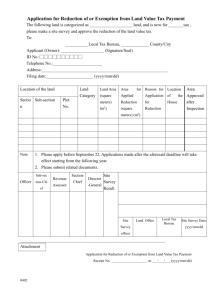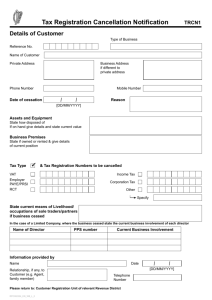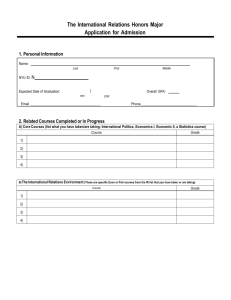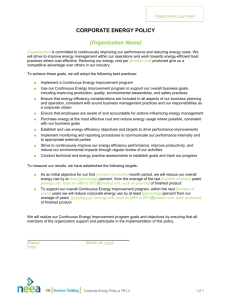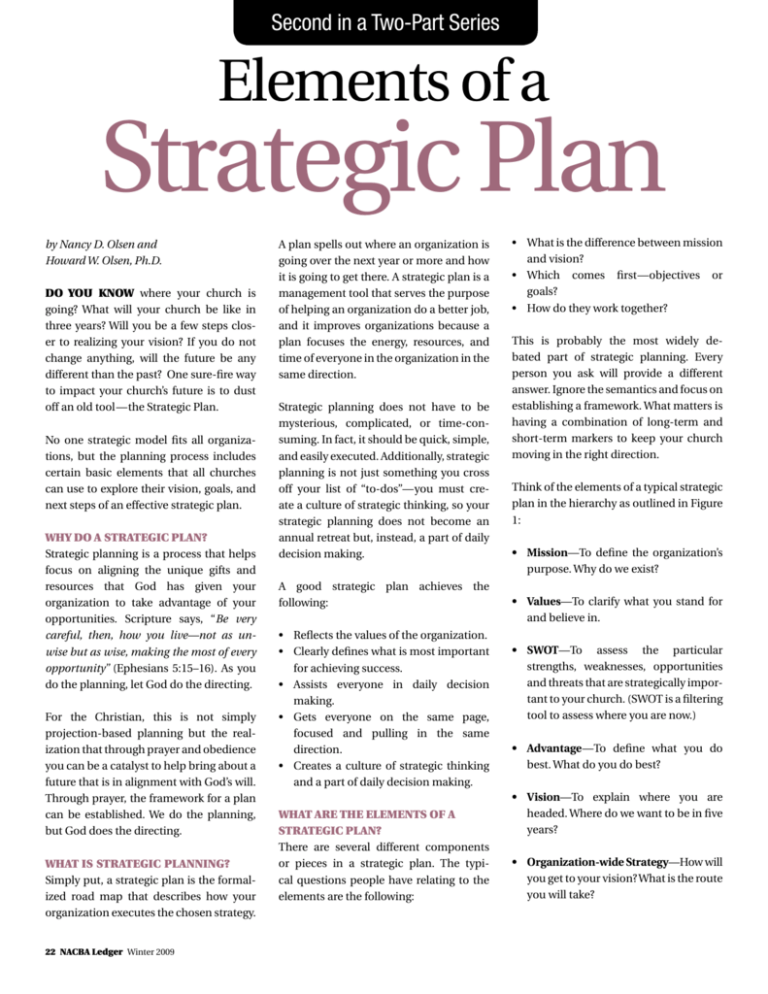
Second in a Two-Part Series
Elements of a
Strategic Plan
by Nancy D. Olsen and
Howard W. Olsen, Ph.D.
DO YOU KNOW where your church is
going? What will your church be like in
three years? Will you be a few steps closer to realizing your vision? If you do not
change anything, will the future be any
different than the past? One sure-fire way
to impact your church’s future is to dust
off an old tool—the Strategic Plan.
No one strategic model fits all organizations, but the planning process includes
certain basic elements that all churches
can use to explore their vision, goals, and
next steps of an effective strategic plan.
WHY DO A STRATEGIC PLAN?
Strategic planning is a process that helps
focus on aligning the unique gifts and
resources that God has given your
organization to take advantage of your
opportunities. Scripture says, “Be very
careful, then, how you live—not as unwise but as wise, making the most of every
opportunity” (Ephesians 5:15–16). As you
do the planning, let God do the directing.
For the Christian, this is not simply
projection-based planning but the realization that through prayer and obedience
you can be a catalyst to help bring about a
future that is in alignment with God’s will.
Through prayer, the framework for a plan
can be established. We do the planning,
but God does the directing.
WHAT IS STRATEGIC PLANNING?
Simply put, a strategic plan is the formalized road map that describes how your
organization executes the chosen strategy.
22 NACBA Ledger Winter 2009
A plan spells out where an organization is
going over the next year or more and how
it is going to get there. A strategic plan is a
management tool that serves the purpose
of helping an organization do a better job,
and it improves organizations because a
plan focuses the energy, resources, and
time of everyone in the organization in the
same direction.
Strategic planning does not have to be
mysterious, complicated, or time-consuming. In fact, it should be quick, simple,
and easily executed. Additionally, strategic
planning is not just something you cross
off your list of “to-dos”—you must create a culture of strategic thinking, so your
strategic planning does not become an
annual retreat but, instead, a part of daily
decision making.
A good strategic plan achieves the
following:
s 2EmECTS THE VALUES OF THE ORGANIZATION
s #LEARLY DElNES WHAT IS MOST IMPORTANT
for achieving success.
s !SSISTS EVERYONE IN DAILY DECISION
making.
s 'ETS EVERYONE ON THE SAME PAGE
focused and pulling in the same
direction.
s #REATES A CULTURE OF STRATEGIC THINKING
and a part of daily decision making.
WHAT ARE THE ELEMENTS OF A
STRATEGIC PLAN?
There are several different components
or pieces in a strategic plan. The typical questions people have relating to the
elements are the following:
s 7HAT IS THE DIFFERENCE BETWEEN MISSION
and vision?
s 7HICH COMES lRSTOBJECTIVES OR
goals?
s (OW DO THEY WORK TOGETHER
This is probably the most widely debated part of strategic planning. Every
person you ask will provide a different
answer. Ignore the semantics and focus on
establishing a framework. What matters is
having a combination of long-term and
short-term markers to keep your church
moving in the right direction.
Think of the elements of a typical strategic
plan in the hierarchy as outlined in Figure
1:
s -ISSION—To define the organization’s
purpose. Why do we exist?
s 6ALUES—To clarify what you stand for
and believe in.
s 37/4—To assess the particular
strengths, weaknesses, opportunities
and threats that are strategically important to your church. (SWOT is a filtering
tool to assess where you are now.)
s !DVANTAGE—To define what you do
best. What do you do best?
s 6ISION—To explain where you are
headed. Where do we want to be in five
years?
s /RGANIZATIONWIDE 3TRATEGY—How will
you get to your vision? What is the route
you will take?
Elements of Your Strategy
Figure 1
Mission/Core Purpose
The underlying “why” you are climbing the mountain, why do you exist?
Core Values/Beliefs
Enduring core beliefs to adhere to no matter what mountain you climb.
Vision (5–10 year)
The specific mountain you are currently trying to climb – the “where.”
Organization-Wide Strategies
The route you intend to take and the general methods you intend to use to reach the top of that
specific mountain.
Strategic Objectives/Priorities (3–5 year)
Intermediate objectives to the top of the mountain. If you have a 5-year vision, these would be threeto four-year intermediate mileposts on the way up the mountain.
Goals (1–3 year) and Actions
Specific methods for climbing the sections of rock and ice that confront you right now. These would
be analogous to detailed annual plans for getting things done this year on the way to the five-year
vision.
s 'OALS—To set goals that convert the
strategic objectives into specific performance targets. What are the oneyear goals you are trying to achieve to
support your objectives?
s !CTION—To set specific action plans
that lead to implementing your goals.
What are the 30, 60, 90 days actions?
s 3CORECARD—To measure and manage
your strategic plan. What are the key
performance measures you can track
in order to monitor if you are achieving
your goals?
HOW DO THE ELEMENTS FIT
TOGETHER?
Because it is easy to confuse how all the elements of a plan come together and where
they go, the visual Strategy Map in Figure
To create a mission statement you need to
understand how God has uniquely gifted
your church with core strengths, abilities, and gifts. You need to embrace your
church’s uniqueness and develop plans
around it. With this in mind, your mission
statement will be one that expresses God’s
call on your church—focusing on who you
are and what you do.
To write a mission ask the following
questions:
s 7HY DO WE EXIST
s 7HAT IS 'ODS PURPOSE FOR OUR CHURCH
s (OW CAN WE WITH LIMITED RESOURCES
really make a difference?
Examples:
Adapted from Jim Collins
s /BJECTIVES—To connect your mission
to your vision. What are the long-term,
3-year out strategic priorities you need
to perform in order to achieve your
vision?
why you exist. A mission statement states
what the church organization intends to
accomplish and the needs it is endeavoring to serve. It also serves as a guide for
day-to-day operations and as the foundation for future decision-making.
2 is a simple, yet clear way of looking at
the whole plan. (see pages 26–27) By placing all the elements of the plan into three
areas, you can clearly see how the pieces
fit together. Each area has certain components of the plan. The three areas are
s 7HERE ARE WE NOW
s 7HERE ARE WE GOING
s (OW WILL WE GET THERE
WHERE ARE WE NOW?
As you think about where your organization is now, you want to look at your foundational elements (mission and values) to
make sure there has not been a change.
More than likely, you will not revise these
two areas very often. Then you want to
look at your current strategic position,
which is where you look at what is happening internally and externally to determine how you need to shift and change.
Here are your foundational elements:
-ission
Mission defines your purpose—the purpose for which you were founded and
s 4O GATHER TO WORSHIP AND BECOME
empowered to serve.
s 4O BE AN OASIS OF FAITH AT A BUSY
crossroad.
s 4O HELP OUR COMMUNITY EXPERIENCE
Jesus in a real and relevant way.
s 4O BUILD AN OVERCOMING CHURCH OUT
of broken lives through the power of
Jesus.
s 4O EXALT THE ,ORD EQUIP THE BELIEVER
evangelize the world, and expand the
Kingdom.
s 4O PRESENT AUTHENTIC #HRISTIANITY TO
our families, community, country and
world.
6alues
Values are enduring, passionate, and distinctive core beliefs. They are guiding
principles that never change. Values are
why we do what we do and what we stand
for. They are beliefs that guide the conduct, activities, and goals of the organization. Values are deeply held convictions,
priorities, and underlying assumptions
which influence our attitudes and behaviors. They have intrinsic value and imporWinter 2009 NACBA Ledger 23
tance to those inside the organization.
Your core values are part of your strategic
foundation.
A church’s values can dominate the kind
of strategic direction it considers or
rejects. When values and beliefs are
deeply ingrained and widely shared by
pastors, board and staff, they become a
way of life within the church and they
mold church strategy.
To write values
questions:
ask
the
following
s 7HAT ARE THE CORE VALUES AND BELIEFS OF
our organization?
s 7HAT VALUES AND BELIEFS GUIDE OUR DAILY
interactions?
s 7HAT IS OUR CHURCH REALLY COMMITTED
to?
Examples:
s Family—We believe there is nothing
more important than strong united
families.
Summary
s /NE SURElRE WAY TO IMPACT YOUR CHURCHS
future is to dust off an old tool—the Strategic Plan.
s .O ONE STRATEGIC MODEL lTS ALL ORGANIZAtions, but the planning process includes
certain basic elements that all churches
can use for next steps of an effective
strategic plan.
s 3TRATEGIC PLANNING IS A PROCESS THAT HELPS
focus on aligning the unique gifts and
resources that God has given your
ORGANIZATION TO TAKE ADVANTAGE OF YOUR
opportunities.
s ! STRATEGIC PLAN IS THE FORMALIZED ROAD
MAP THAT DESCRIBES HOW YOUR ORGANIZATION
executes the chosen strategy.
A Godly vision is based on God’s will for the
church. It is a picture of seeking the needs of
other people and meeting those needs. It is vitally
connected to the heart of God and His perspective.
s Excellence—We believe excellence
honors God and inspires greatness.
s Equipping—We believe in equipping
the saints for ministry and life by helping them to operate in their spiritual
gifts.
s Prayer—We believe in the power of
prayer, and that makes a critical difference in all we attempt to achieve.
We are to be a house of prayer for all
nations.
s Authenticity—through authentic living, biblical authority, worship, prayer,
and spirit.
37/4 (Strategic Position)
The SWOT (Strengths, Weaknesses,
Opportunities, Threats) is a tool to help
match internal organizational strengths
with external opportunities to meet the
needs of your constituents and community best. Think of the SWOT as a filtering tool to assess your current strategic
position. A good understanding of your
strengths and weaknesses, your opportunities, and the external threats is essential
to the assessment.
(Continued on page 28)
s 4HERE ARE SEVERAL DIFFERENT COMPONENTS OR
pieces in a strategic plan which are discussed in this article.
s 3TRATEGIC PLANNING NEEDS INCLUDE SETTING
GOALS TO BUILD ON YOUR CHURCHS STRENGTHS
SHORE UP THE WEAKNESSES CAPITALIZE ON THE
OPPORTUNITIES AND RECOGNIZE THE THREATS
s &ORMING A STRATEGIC VISION SHOULD PROVIDE
long-term direction and infuse the church
with a sense of purposeful action.
s 3TRATEGIC OBJECTIVES STATE THE BROAD DIRECTION
and goals and work towards converting your
mission into actions that will accomplish
your vision and help sustain your unique
advantage.
s 3TRATEGY ESTABLISHES A WAY TO MATCH YOUR
CHURCHS STRENGTHS WITH OPPORTUNITIES SO THAT
your church comes to mind when people
have a need.
24 NACBA Ledger Winter 2009
s Committed community—through intimacy within the community, servant
leadership, genuine relationships, and
beauty in diversity.
s #OMMUNICATE THE PLAN TO EVERYONE IN YOUR
ORGANIZATION ! STRATEGIC PLAN IS A LIVING
dynamic document. Strategic planning is
about keeping the plan active so that it does
not gather that proverbial dust.
Authors
$R (OWARD 7 /LSEN IS
the president and Nancy
Olsen is the vice president
of M3 Planning, Inc., a
lRM THAT SPECIALIZES IN
HELPING ORGANIZATIONS
develop their strategy to
accomplish their growth
plans. They can be reached
VIA THEIR 7EB SITE AT WWW
mychurchplan.com.
Company: Community Church
Plan:
Strategic Plan Figure 2
Where are we now?
How are we going to get there?
Foundation
Strategic Objectives and Goals
Our Mission
Our mission is to present authentic Christianity to our families, community,
country, and world
Mission/Financial—How will we accomplish our mission?
Mission: To stay focused on money
to ministry.
Revenue Generation: To increase
funds from giving.
s 4O SPEND OF OUR BUDGET ON
evangelism by the end of the year
s 4O AVERAGE + A WEEK IN TITHES
and offerings by 12/31/YYYY
Our Core Values
s &AMILY7E BELIEVE THERE IS NOTHING MORE IMPORTANT THAN STRONG UNITED
families.
s %XCELLENCE7E BELIEVE EXCELLENCE HONORS 'OD AND INSPIRES GREATNESS
s 2ELATIONSHIPS7E BELIEVE THAT LOVING RELATIONSHIPS SHOULD PERMEATE EVERY
aspect of church life.
s %QUIPPING7E BELIEVE IN EQUIPPING THE SAINTS FOR MINISTRY AND LIFE BY
helping them to operate in their spiritual gifts.
s $EVOTION7E BELIEVE THAT FULL DEVOTION TO #HRIST AND (IS CAUSE ARE NORMAL FOR
every believer.
s 3OUND $OCTRINE7E BELIEVE THAT TEACHING AND DOCTRINE SHOULD BE BALANCED ON
the historical roots of Christianity that shaped the theology and orthodoxy of faith.
Sound doctrine is held in high esteem.
s 0RAYER7E BELIEVE IN THE POWER OF PRAYER AND THAT IT MAKES A CRITICAL
difference in all we attempt to achieve.
s #HARACTER7E BELIEVE THAT CHARACTER IS MORE IMPORTANT THAN TALENT
Constituents—How we provide value
Current services: Provide excellent
service in all family areas.
Current constituents: Increase the
involvement in small groups.
Busters and Generation X—
Ages 35–44
New Millenium Generation—
Ages 25–34
s 4O PROVIDE EXCELLENCE IN FAMILY MINIStry education classes by 12/YYYY
s !DD MORE SMALL GROUPS THIS YEAR
s 4O PROVIDE EXCELLENCE IN THE AREA OF
media by expanding and
enhancing technology by 3/31/YYYY
s )NCREASE CHURCHWIDE SOCIAL ACTIVITIES
this year
s #LASSROOMS TO BE COMPUTER CAPABLE
by 12/31/YYYY
s %VANGELISM7E BELIEVE THAT AN EFFECTIVE CHURCH SERVICES ITS COMMUNITY AND
treats everyone with love, respect, and dignity.
s 7ORSHIP7E BELIEVE THAT FULL DEVOTION TO #HRIST AND (IS CAUSE ARE NORMAL FOR
every believer.
Operational—Which processes we must excel at
Facilities: To provide adequate facilities and maintain property.
Administrative Management:
To improve office efficiency.
Unique Advantage
s 4O PREPARE OUR CURRENT BUILDING FOR
sale in Spring YYYY
s 4O HIRE OFlCE MANAGER AND
assistant by 11/YYYY
What we do best
s 4O DETERMINE NEEDS AND DEVELOP
plan for new facility by 6/30/YYYY
s 4O HIRE A NEW STAFF MEMBER WITH AN
annointing in the area of music and
fine arts by 11/31/YYYY
s 7E ARE YOUNG MINDED PROGRESSIVE AND CULTURALLY RELEVANT MESSENGERS OF THE
Gospel.
s 4O DEVELOP AN ACCURATE 9999
budget that we follow and monitor
s 2ESOURCES TO SERVE THE SPIRITUAL NEEDS IN OUR COMMUNITY
s -ATURE AND TRAINED LEADERS
People—How we must learn and improve
Organization-wide Strategies
How we wll get there
s 9EAR ONE4RAINING LEADERS
s 9EAR TWO'ROWING MINISTRY TEAMS
s 9EAR THREE#OMMUNITY PENETRATION
Leadership: Create a leadership
culture.
Staff Development: Learn and adopt
best practices.
s 4RAIN LEADERS IN ,EVEL /NE BY YYYY
s (AVE EACH PASTOR ATTEND ONE BEST
practice church conference each
year starting in YYYY
s 4O PROVIDE A TRAINING PROGRAM FOR ALL
levels of leadership
s 4RAIN LEADERS IN ,EVEL 4WO BY
6/30/YYYY
s 4RAIN LEADERS IN ,EVEL 4HREE BY
10/31/YYYY
26 NACBA Ledger Winter 2009
Where are we going?
Scorecard
How we measure success
Operational Efficiency: To be financially stable.
Measure
Target
s 4O HAVE + IN A SAVINGS ACCOUNT
by 12/YYYY
s 4O MAKE WEEKLY CHURCH PAYMENTS
in order to cut interest and add to
the principle
New Constituents: Increase
numbers of members in all groups.
Baby Boomers—Ages 45–55
s 0LAN SPECIAL ACTIVITIES WITH
emphasis on them by 9/30/YYYY
Vision
s $EVELOP COMMUNICATION TOOL BY
2/YYYY
What our church will look like
To be the premier charismatic, seeker driven, community church in the state.
Ministry Management: To develop
programs so they can be run by
members.
s 4O DEVELOP OUR MISSIONS PROGRAM
for extensive international
outreaches by 12/31/YYYY
Communications Management:
To maintain database
management and all
communications.
s 4O HAVE A MONTHLY ONLINE
newsletter by 9/28/YYYY
s 4O PURCHASE A CHURCH
management system by
12/YYYY
Scorecard
How we make strategy a habit
Culture: Be the most creative and
culturally relevant church around.
s 4O PUSH EVANGELISM ENVELOPE BY
studying the most progressive
churches in America by 12/YYYY
s 4O ATTEND NEW CHURCHES THAT ARE
progressive by 9/YYYY
s 4AKE ALL ELDERS TO PROGRESSIVE
church by 1/YYYY
© 2007 M3 Planning – All rights reserved
Winter 2009 NACBA Ledger 27
(Continued from page 24)
The SWOT is only as good as the information it contains. Gathering information
from your constituents and stakeholders
about the effectiveness of your programs,
services, and church is essential for the
SWOT to identify key issues. The purpose
of a SWOT is to help produce a good fit
between your church’s internal resources
and capabilities and your external environment.
When you plan you will need to set goals
to build on your church’s strengths, shore
up the weaknesses, capitalize on the
opportunities, and recognize the threats.
Assess your strengths and weaknesses by
answering these questions: what do we do
well, and where could we improve?
Assess your opportunities and threats by
asking what opportunities should we take
advantage of and are there any emerging
trends that might affect our organization?
Unique Advantage
Just what is a unique advantage? It is simply the answer to “what does your church
do best?” Your unique advantage is what
your church does or potentially could do
better than similar organizations. The
result of a well-developed and executed strategic plan is to develop a unique
advantage. It is what you do best that
draws constituents/stakeholders to use
your programs and services instead of
similar organizations. Successful churches deliberately make choices to be unique
and different in activities that they are really, really good at doing and they focus all
of their energy in these areas.
Your unique advantages are the foundation, the cornerstone of your strategic
plan. Throughout the planning process
you will need to evaluate every part of
your plan to determine whether it supports or detracts from this.
To identify your unique advantages ask
the following questions:
28 NACBA Ledger Winter 2009
Resources
Strategic Planning Online System:
-Y#HURCH0LANCOM IS A 7EBBASED SYSTEM STRATEGIC PLANNING SYSTEM 4HROUGH A SELFGUIDED STEP
by-step, cost-effective process, a church can quickly and efficiently build, monitor, and revise their
growth plans as God directs. MyChurchPlan will assist a church in developing a strategic plan, creating
professional reports without having to recreate the wheel every time, and implementing the plan. It will
save the church valuable time, create a plan that is dynamic and easily editable, produce professions
reports, and increase performance through execution.
Books:
.ANCY $ /LSEN AND (OWARD 7 /LSEN 0H$ Strategic Planning Made EasyTM for Nonprofit Organizations: A Practical Guide, 2007.
This book is designed to help executive directors and their boards build and execute their strategy
THROUGH A COSTEFFECTIVE SELFGUIDED PROCESS LEADING TO EFFECTIVELY FULlLLING THE ORGANIZATIONS PURPOSE
Through thought provoking questions, relevant examples and worksheets, the book guides nonprofits
THROUGH THE PLANNING PROCESS 4HE /NE0AGE 3TRATEGIC -AP HELPS YOU VISUALIZE THE PLAN
Erica Olsen. Strategic Planning For Dummies, November 2005
Strategic Planning For Dummies brings you everything you need for the next phase of church growth.
Learn how to build and sustain your competitive advantage, develop a vision for you and your organiZATION SET UP AN ONGOING PROCESS FOR MARKET ASSESSMENT DEVELOP AN INTEGRATED STRATEGY MONITOR WITH
a scorecard and make strategy a habit.
s 7HAT DOES YOUR CHURCH DO BEST
s 7HAT CAN YOUR ORGANIZATION POTENTIALLY
do better than any other organization?
s 7HAT UNIQUE SKILLS RESOURCES GIFTS AND
capabilities has God placed in your
church?
Examples:
s 7E ARE YOUNGMINDED PROGRESSIVE AND
culturally relevant messengers of the
Gospel of Christ.
s 7E HAVE A PRIME LOCATION
s 7E HAVE "IBLEBASED PREACHING
s 7E ARE A CHURCH OF SMALL HOME GROUPS
s 7E HAVE AN EXTENSIVE CARE MINISTRY
s 7E HAVE A STRONG YOUTH MINISTRY
WHERE ARE WE GOING?
The elements of the question, “Where are
we going?” help you answer other questions, such as, What will my church look
like in the future? Where are we headed?
What is the future I want to create for my
church? The following elements help you
define the future for your church:
6ision
A vision is a picture of what your church’s
future makeup will be and where the
organization is headed. Vision provides
a clear mental picture, by faith, of what
your church will look like in five to ten
years from now. Forming a strategic
vision should provide long-term direction, delineate the organizational activities to be pursued, the capabilities it plans
to develop, and infuse the church with a
sense of purposeful action. It serves as a
unifying focal point for everyone in the
organization like a North Star. It delineates
the future focus and where the church is
going.
A Godly vision is based on God’s will for
the church. It is a picture of seeking the
needs of other people and meeting those
needs. It is vitally connected to the heart
of God and His perspective. A vision which
is inspired by God is God-sized and will
require the power of God to fulfill. A Godly
vision makes your heart surge, carries you
to heights you never dreamed possible,
and causes exponential growth. You are
empowered and motivated by it. It seizes
hold of you and orders your thoughts and
actions. Scripture says, “Record the vision
and inscribe it on tablets, that the one who
reads it may run.” (Habakkuk 2:2)
To write a vision, pray and seek God’s wisdom by asking the following questions:
s 7HAT WILL OUR CHURCH LOOK LIKE TEN YEARS
from now?
s 7HERE IS 'OD DIRECTING OUR CHURCH
s 7HAT IS 'ODS VISION FOR OUR CHURCH
Examples:
s 4O BE AN INTERDENOMINATIONAL CELL
based, multi-congregational church of
believers in our community who practice authentic Christian community.
s 4O BE A PLACE WHERE PEOPLE SEARCHING
to know God are welcomed and taught
Biblical principles and relevant Christian community.
3TRATEGIC /BJECTIVES0RIORITIES
Strategic objectives are long-term, continuous strategic areas that get you moving from your mission to achieving your
vision. Objectives explain how you will get
there. In other words, objectives are longterm (3–5 years) general areas that state
how your organization will get from its
mission (where you are now) to its vision
(where you are going).
s 4O DEVELOP A LOVING AND CARING #HRIStian community effecting a global
impact for Christ through its local,
regional, and international outreach.
s 4O BE THE PREMIER SEEKERDRIVEN COMmunity church in the state.
s 4O BECOME A PREMIER MULTICULTURAL
soul winning, disciple-making church
in the area, renowned worldwide for
our commitment to missions and our
passion for excellence, service, and
team work.
Objectives are also called strategic priorities, initiatives, and cornerstones. It
is helpful to think of objectives as broad
general area. Objectives state the broad
direction; goals then operationalize that
direction. They are the continuous strategic activities necessary to achieve your
vision. They define what your organization is intending to accomplish both
programmatically and organizationally.
Objectives work towards converting your
mission into actions that will accomplish
your vision and help sustain your unique
advantage.
HOW WILL WE GET THERE?
Knowing how you will reach your vision
is the meat of your strategic plan, but it
is also the most time consuming. The
reason it takes so much time to develop is
because there are a number of routes from
your current position to your vision. Picking the right one determines how quickly
or slowly you get to your final destination.
The parts of your plan that lay out your
roadmap are as follows:
Sign up to accept online donations with TransactU
and pay nothing until 2010!
With TransactU, you can:
sõõõ!CCEPTõONLINEõDONATIONSõEVENõWHENõYOURõOFlCEõDOORSõAREõCLOSED
sõõõ/FFERõTHEõCONVENIENCEõOFõDONATINGõWITHõDEBITõCARDS
õ CREDITõCARDSõORõECHECKS
sõõõ#USTOMIZEõDONATIONõPAGESõTOõMATCHõYOURõWEBSITE
sõõõ"EõPROTECTEDõWITHõ0#)CERTIlEDõSECURITY
3CHEDULEõYOURõDEMOõATõwww.ServiceU.com/FreeTransactU
ANDõSEEõFORõYOURSELFõHOWõ4RANSACT5õCANõDRAMATICALLY
INCREASEõYEARENDõGIVING
www.ServiceU.com
866-709-7238
õ)NITIALõSETõUPõFEEõWAIVEDõUNTILõõONEõYEARõCONTRACTõREQUIRED
/FFERõENDSõõAVAILABLEõTOõNEWõ4RANSACT5õCLIENTSõONLY
-USTõHAVEõCOMPATIBLEõMERCHANTõACCOUNTõTHROUGHõ3ERVICE5õ#ORPORATION
ANDõPAYõASSOCIATEDõMERCHANTõACCOUNTõFEES
An administrator devoted to the successful
implementation of the plan is key. The plan
needs to be supported with people, money, time,
systems, and, above all, communication.
To write objectives ask these questions:
Examples:
s 7HAT ARE THE KEY ACTIVITIES THAT YOU
need to perform in order to achieve
your vision?
s 7HAT AREAS DO WE NEED TO FOCUS ON OVER
the next 3–5 years to accomplish our
vision?
s
s
s
s
s
s
s
/VERALL.UMBER OF LIVES CHANGED
ST YEAR"IRTH OF THE CHURCH
ND YEAR,EADERSHIP DEVELOPMENT
RD YEAR'ROWTH
TH YEAR$ISCIPLESHIP
TH YEAR#OMMUNITY OUTREACH
TH YEAR)NTERNATIONAL OUTREACH
Examples:
s 4O IMPACT STRATEGICALLY MORE LIVES EACH
year.
s 4O MANAGE OUR CHURCH ON A lSCALLY
sound operating basis.
s %XPAND PROGRAMSSERVICES TO EXISTING
congregation.
s 4O SERVE MORE PEOPLE IN THE COMMUNIty through new programs and services.
s 4O IMPROVE INTERNAL PROCESS CONTINUally to realize efficiencies.
s 4O IMPROVE INTERNAL COMMUNICATIONS
s 4O DEVELOP THE LEADERSHIP ABILITIES AND
potential of our staff.
Strategy
Strategy establishes a way to match your
church’s strengths with opportunities so
that your church comes to mind when
people have a need. A strategy is like an
umbrella. It is a general statement(s) that
guides and covers a set of activities. You
can develop one strategy for your church
or guiding statement for each year.
Strategy answers the question “how.” It
explains how you will travel to your final
destination.
Consider listing the top one to two strategies or long-term activities your church
needs to pursue in order to achieve its
vision by asking how will we achieve our
vision and how can we best match our
strengths in a way that provides value and
is perceived by our constituents?
30 NACBA Ledger Winter 2009
Goals convert your strategic objectives
into specific performance targets. Effective SMART goals clearly state what you
want to accomplish, when you want to
accomplish it, how you are going to do it,
and who is going to be responsible. Each
goal should be specific and measurable.
With short-term goals, the organization
converts the mission, vision, and longterm objectives into performance targets.
Realistic goals ought to serve as a tool for
stretching an organization to reach its full
potential.
It is important for the church to view
goals as motivational targets, and exciting, measurable milestones for the future.
Think about achieving them in a 12–18
month timeframe. Write goals to build
your unique advantage. Additionally, use
your SWOT analysis to write goals. Match
your strengths with opportunities, shore
up your weaknesses and guard against
threats.
Goals can be difficult to set because they
should be faith-stretching without being
presumptuous.
Goals ought to serve as a tool for stretching a church to reach its full potential.
This means setting them high enough to
be challenging to energize the organization and its strategy. Prayerfully seek God’s
guidance in setting faith goals. Let God
give you things He wants you to do. Hold
your plans before the Lord.
The following is an explanation of the criteria for SMART goals:
s Specific—Goals must answer the questions: How much? What kind of performance is to be accomplished?”
s Measurable—Goals must be stated
in measurable or quantifiable terms:
Can we measure this goal? How will we
know if we achieved this goal?
s Aggressive yet Achievable—Is the goal
aggressive yet achievable? Goals must
provide a stretch that inspires people
to aim higher. Set goals you know you
can realistically achieve.
s Relevant/Realistic—Is the goal relevant to achieving the objective? Goals
must maintain consistency and focus.
s Time Specific—Is the goal time specific? Goals must answer the question,
“by when is it to be accomplished?”
Write goals by asking these questions:
s 7HAT ARE THE n TO nYEAR GOALS WE ARE
trying to achieve to support our strategic objective?
s 7HAT ARE YOUR SPECIlC MEASURABLE AND
realistic targets of accomplishment?
Action Items
Action items are plans that set specific actions that lead to implementing
your goals. Action items are basically a
“To-Do List” for each goal. It involves listing out the concrete steps that you need to
accomplish in order to achieve your goals.
An action plan explains who is going to do
what, by when, and in what order for the
church to reach its goals. The design and
implementation of the action planning
depend on the nature and needs of the
organization.
To ensure implementation of action
items, it is important to assign responsibilities and deadlines. A great method to
get buy-in from your stakeholders is to
assign each goal to a board member, staff, or
volunteer. Ask him/her to write the action
plan and be responsible for making sure
each task is accomplished. Another method is to identify all the actions that need to
occur in the next ninety days. You can
continue this same process every ninetyday increment until the goal is achieved.
To write action items ask, “What are we
going to do in the next 90, 60, 30 days to
work towards this goal?”
Scorecard
To help monitor your strategic plan, one
of the best tools around is the Balanced
Scorecard developed by Kaplan and Norton from Harvard. The scorecard is to be
used as both a measurement and management tool to assist in fulfilling an organization’s vision. With it, you can actively
track progress towards your goals.
For each goal put a measurement and
target on a scorecard (in Excel). With the
scorecard, you can actively track your
progress on a monthly basis. To begin
using the scorecard, select the “Top Five”
key goals that you want to measure that
will have the most impact in moving your
church forward.
To develop a scorecard ask, “what are the
key performance measures you can track
in order to monitor if you are achieving
your goals?”
Execution
Implementation is the most difficult
part of the planning process: it is actually achieving the goals set out in the plan
while remaining alert and flexible to new
opportunities as they unfold. The overall
aim is integrating the strategic planning
with daily, weekly, and monthly routines.
It is good to remember that a plan that is
well-implemented brings Godly success
to the church.
An administrator devoted to the successful implementation of the plan is key. The
plan needs to be supported with people,
money, time, systems, and, above all,
communication. Communicate the plan
to everyone in your organization. Hold
a monthly or quarterly strategy meeting
to report on the progress toward achieving the goals. Take corrective actions as
needed. Above all, remember that implementing the plan requires continued
daily prayer for direction accompanied by
obedient action in response to what God
reveals.
CONCLUSION
A strategic plan is a living, dynamic document. It drives your church and must be
integrated into every fiber of your organization, so all staff is helping to move the
church in the same direction. All the best
missions and strategies in the world are a
waste of time if they are not implemented.
To be truly successful, the plan cannot
gather dust on the bookshelf. You know
what “shelf” we are talking about.
Strategic planning is about keeping the
plan active so that it does not gather that
proverbial dust. Know what your end
result looks like and where your milestones
should be. Plan your near-term actions
and evaluate your progress each quarter.
Are you where you thought you would be
if you had been on target? Or, if you are off
target, how far are you off? The course correction to put you back on track becomes
your next action plan. When your church
has a clear plan and acts according to the
plan, you are going to go from where you
are to where you want to go, therefore,
ensuring your success!
Insurance for Churches and Other Houses of Worship
Trusted
Business partner
Serving Independent
Agents Since 1985
Preferred
Status with our carriers
'RPHVWLFDQG,QWHUQDWLRQDO
Competitive
Pricing on all products
For more information, please have your
insurance agent contact our office:
FKDULW\ILUVWLQIR#FKDULW\ILUVWFRP
www.charityfirst.com
3URGXFWV$YDLODEOHQDWLRQZLGH
5DWHG´$([FHOOHQWµRUEHWWHU
E\$0%HVW
&$/LFHQVH%
Winter 2009 NACBA Ledger 31


